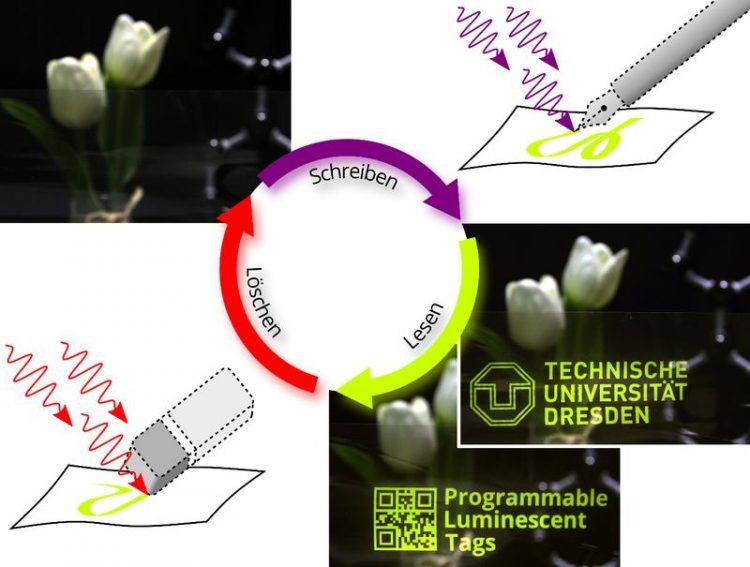Invisible tags: Physicists at TU Dresden write, read and erase using light

This figure shows the multiple writing, reading and erasing cycles. The UV-illuminated patterns can be erased by infrared light again and again. M. Gmelch and H. Thomas, TU Dresden
Prof. Reineke and his LEXOS team work with simple plastic foils with a thickness of less than 50 µm, which is thinner than a human hair. In these transparent plastic foils, they introduce organic luminescent molecules.
In the beginning, these molecules are in an inactive, dark state. By locally using ultraviolet irradiation, it is possible to turn this dark state into an active, luminescent one. By mask illumination or laser writing, activated patterns can be printed onto the foil with a resolution that is comparable to common laser printers.
Similar to glow-in-the-dark stickers, the patterns can be brought to shine and the imprinted information can be read. By illuminating with infrared light, the tag is erased completely and new data can be written into it.
The working principle of these programmable transparent tags is based on the well-known oxygen molecule. Oxygen is present in the plastic foil and steals the light energy from the glowing molecules. Ultraviolet radiation induces a chemical reaction which efficiently removes the oxygen from the layer.
In consequence, the luminescent molecules are activated and are able to emit light. The deactivation process using infrared light is based on a temperature rise of the foil, leading to an increased oxygen permeability and therefore a refilling of the layer with oxygen.
These novel tags can be manufactured in any size. The low material costs of less than two euro per square meter promise a wide range of possible applications: Information such as barcodes, serial numbers or addresses can be hidden for on-demand readout only. Also, these invisible tags could propel document security and anti-counterfeiting to a whole new level.
Prof. Reineke is already thinking further ahead: ‘Those invisible and re-writable tags can be used in a multitude of ways. We can manufacture such tags thinner than conventional barcode stickers. These tags can become a versatile alternative to many frequently technology-laden solutions for information exchange in our daily life.
These luminescent tags make electronics obsolete at the location, where the information is stored. The development and optimisation of such systems open a broad research field bringing together material development, process engineering, and fundamental research in an interdisciplinary fashion.
About the Light-Emitting and eXcitonic Organic Semiconductor (LEXOS) group:
The LEXOS group is part of the Dresden Integrated Center for Applied Physics and Photonics Materials (IAPP) and the Institute of Applied Physics of the Technische Universität Dresden and led by Prof. Sebastian Reineke.
One focus of the LEXOS group is the investigation of excitonic and luminescent systems covering organic and other related emerging materials. The group has strong expertise in the optical spectroscopy of such systems.
One current example is the investigation of organic biluminescence, where luminophores show both fluorescence and phosphorescence at room temperature.
Further, the LEXOS group has long-standing expertise in the research and development of organic light-emitting diodes (OLEDs). The current OLED research comprises stack and concept development, devices optics, charge transport and recombination studies, long-term stability investigations, material development (dopant and emitter materials), and device integration.
Prof. Dr. Sebastian Reineke
Institute of Applied Physics
Tel: +49 351 463 38686
Email: sebastian.reineke@tu-dresden.de
M. Gmelch, H. Thomas, F. Fries, S. Reineke, Programmable transparent organic luminescent tags. Sci. Adv. 2019; 5: eaau7310.
Media Contact
All latest news from the category: Physics and Astronomy
This area deals with the fundamental laws and building blocks of nature and how they interact, the properties and the behavior of matter, and research into space and time and their structures.
innovations-report provides in-depth reports and articles on subjects such as astrophysics, laser technologies, nuclear, quantum, particle and solid-state physics, nanotechnologies, planetary research and findings (Mars, Venus) and developments related to the Hubble Telescope.
Newest articles

First-of-its-kind study uses remote sensing to monitor plastic debris in rivers and lakes
Remote sensing creates a cost-effective solution to monitoring plastic pollution. A first-of-its-kind study from researchers at the University of Minnesota Twin Cities shows how remote sensing can help monitor and…

Laser-based artificial neuron mimics nerve cell functions at lightning speed
With a processing speed a billion times faster than nature, chip-based laser neuron could help advance AI tasks such as pattern recognition and sequence prediction. Researchers have developed a laser-based…

Optimising the processing of plastic waste
Just one look in the yellow bin reveals a colourful jumble of different types of plastic. However, the purer and more uniform plastic waste is, the easier it is to…


